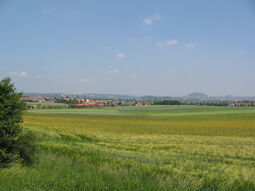
Fluda city in the Fulda Gap.
The location[]
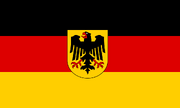
The unofficial OTL flag of the German Federal Republic (West Germany)\German.
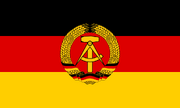
The East German flag.
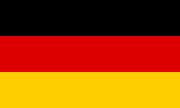
The official West German\German flag.
The area known as the Fulda Gap lies between the Hesse-Thuringian border (the former intra-German border between the GDR and FRG), and Frankfurt am Main that contains two corridors of lowlands which tanks might have driven in a surprise attack effort by the Soviets and their Warsaw Pact allies to gain any crossing points over the Rhine River.
The Fluda Gap is named after the small city of Fulda, which is it's self name after the River Fulda. The city has a population of 60,000 people, nestled among rich, rolling farmland laid out in a 'checkerboard' farm plantation fashion. It was was strategically important during the Cold War and is near the Knüllgebirge (or Knüll) and Vogelsberg Mountains.
The Knüllgebirge is a small, heavily forested, mountain range in Hesse, located in the Northern part of Hesse approximately 45 km South of Kassel. The highest local peak is the Eisenberg having an altitude of 635.5m. The only major town is Schwarzenborn with a population of 1,158 (2006), which is also the site of W. German (and now German) army Jägerregiment 1 headquarters.
The Vogelsberg Mountains or Vogelsberg (German for Bird's Mountain) are a large, 19,000,000 year old, volcanic massif in eastern Upper Hesse separated from the Rhön Mountains by the Fulda River and its valley. The main peaks of the Vogelsberg Mountian is Taufstein, 773 m (2,536 ft), and Hoherodskopf, 763 m (2,503 ft). It is part of the north and Germany's Central Uplands (die Mittelgebirge). It has a marine west coast climate.
History[]
Geography was a major tactical in both the Napoleonic Wars between France and Germanyfand the Second World War as the the U.S. XII Corps found out in 1945.
The plan[]
The northern route through the Gap passes south of the Knüllgebirge and then continues around the northern flank of the Vogelsberg Mountains; the narrower southern route passes through the Fliede and Kinzig Valleys, with the Vogelsberg to the north and the Rhön Mountains and Spessart Mountains to the south. This lead to the easy going landscape of the Rhine Valley, which would have favour a Soviet attempt to set up an advanced base and ultimately cross the Rhineland the less obstructive Main River before NATO could intervene properly.
The Fulda Gap route was less suitable for mechanized troop movement than was the North German Plain, but it offered an avenue of advance direct to the heart of the U.S. military in West Germany, Frankfurt am Main. The Main River is a tributary of the Rhine River. Frankfurt-au-Mien was not only West Germany's financial heart, but also home to two large airfields (the Rhein-Main Air Base) that were designated to receive U.S. reinforcements in the event of war. The southern Danube route was a another far less viable route for invading Germany. The city of Darmstadt, which had many American troops in it, was also a major Warsaw Pact target.
One of the major targets was the central and southern parts of Germany's Rhineland which had much coal, lead, lignite, magnesium, oil and uranium, as well as some building stone, iron ore, tin ore and lead deposits, in it. Cities and towns like Saarbrücken, Dortmund, Koblenz and Düsseldorf were major economic power houses in Napoleonic times, WW1 and WW2.
Knüllgebirge, Vogelsberg, Osnabrück, Schwarzenborn, Darmstadt, Ramstine, Frankfurt-au-Mien, Wildflecken, Saarbrücken, Dortmund, Koblenz and Düsseldorf were all on the Soviet target list. Linz, Bad Kotzing and Munich would fall to the Czechoslovak. The cities of Gotha, Shul, Wimar, Jena, Rostok and Erfurt were in NATO's long term sights and would have been either hit with a pre-emptive strike to stop a Warsaw Pact invasion or with a retaliation strike after an invasion had started.
The forces[]
NATO[]

3 Leopard 2A5 tanks of the German Army (Heer). W. Germany also used them.
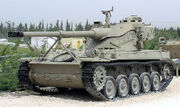
An Israeli owned AMX 13 light tank. France used them in the Cold War.
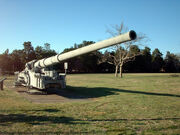
The American atomic artillery peace ‘Atomic Annie’.

A German F-104F in 1960. In 1962 this aircraft collided with three others after a pilot error. The FRG's Luftwaffe used about 100 of them over the years.

The flag of the USA.
During the Cold War the Fulda Gap considered an obvious routes for a hypothetical Soviet tank and/or East German attack upon West Germany and thus dominated much of North Atlantic Treaty Organisation (NATO) war planning during the Cold War. High kill rate weapons like nuclear missiles, the atomic Davy Crockett Weapon System, tactical missile launcher systems, special atomic demolition munitions along with the AH-64 Apache attack helicopters, and A-10 ground attack aircraft which were developed with such an eventuality in mind.
The force was small at first. The reconnaissance and security along the border between the U.S. and Soviet zones of occupation in Germany in the area north and south of Fulda was the mission of elements of the U.S. 3rd and 1st Infantry Divisions from 1945 until June–July 1946. by 1979 other units had arrived including the 108th Military Intelligence, based in Wildflecken, of which the Delta Company Rangers were assigned to strike at the supply lines and command structures of any invading Soviet forces.
In September 1980, the 533rd Military Intelligence (MI) Battalion was reactivated in Frankfurt and assigned to the 3rd Armoured Division. The 533rd MI Battalion deployed assets in the Fulda Gap to provide electronic warfare capability for the 3rd AD Commander. 144th Ordnance Company was in charge of much of the ammunition delivery and supply work for them.
The Gap itself was the responsibility of Fulda based armoured cavalry regiments (the 14th ACR, and later the 11th ACR). An Armoured Cavalry Regiment (ACR) is a unique mechanized reconnaissance unit of approximately 5,000 men. In the years after replacing the 14th ACR, the 11th ACR or “Blackhorse Regiment,” as it was called, was the main observation unit of the local American forces in that part of West Germany, screening the invading Warsaw Pact forces and reporting their positions to NATO. The W. German Army Jägerregiment 1 headquarters was also in the near by town of Schwarzenborn. Ultimately, backing up the 11th Armored Cavalry was the rest of V Corps: the 3rd Armored and 8th Infantry Division, consisting of another 700 Abrams tanks and an equal number of Bradley fighting vehicles, plus attack helicopters and artillery. American air-power was in the form of A-10 tank killers and F-16 fighter bombers that were capable of being called upon for battlefield close air support if needed. The West German forces at Schwarzenborn were also in the immediate vasinity and thus also responsible for looking after the Gap.
The U.S. Army and Air Force later created the operational doctrine called Air-Land battle. 'Air-land battle' was a tactical and strategic fusion of ground and air power designed to break up Soviet tank formations. The air aspect of Air-land battle would use aircraft like the F-111 bomber to conduct deep strikes against reinforcements, HQs and supplies to the front lines, while Air Force A-10 and Army Apache helicopters would attack enemy front-line units, particularly the tanks and APCs.
The land aspect forces would be tanks, APCs and infantry holding the front lines, supported by artillery in order to stop any further local advance beyond the then established front line. NATO troops would have come from places like Darmstadt and Osnabrück. Gotha, Shul, Wimar, Jena and Erfurt were in NATO's long term sights and would have been hit with a pre-emptive strike to stop a Warsaw Pact invasion or with a retaliation strike after an invasion had started. The British Army Of the Rhine would be coming from Osnabrück, W. Germany's Army Jägerregiment would come from Schwarzenborn and the Americans would come from Darmstadt, Frankfurt-au-Mien and Wildflecken.
Forty years after World War II, the United States maintained 250,000 troops in West Germany and the UK had 20,000 troops over there in formations like the British Army of the Rhine (BAOR). The USA's, Canada's, France's and UK's contributions were part of a NATO military force of nearly 990,000 personnel, who were mostly West Germans. Western officials said the Soviet Bloc's Warsaw Pact had nearly 1.2 million personnel in neighbouring East Germany and Czechoslovakia, most of whom were Soviets.
The near by Observation Post Alpha is located on the Rasdorfer Berg between Rasdorf, Hesse and Geisa, Thuringia. It is a part of the Rhön hills. The Bundesstrasse 84 passing the post follows the historical route of the Via Regia from Fulda to Eisenach. day, the "Point Alpha" memorial commemorates the Observation Point's four decades of existence and as a reminder of the Cold War's devison of Germany.
The Cologne Post was a newspaper published for members of the BAOR during this period.
Phantom FGR Mk 2s fighter bombers, Leopard 2A5 tanks and Tornado GR Mk 1s strike aircraft would have been used extensively.
Warsaw Pact[]
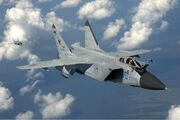
A Russian Air Force MiG-31 in flight over Russia. The USSR also used them.
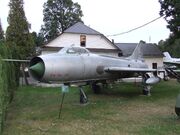
A Soviet Su-7 in a Skarżysko air museum.
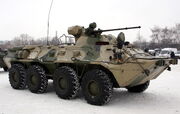
A Russian BTR-80A APC. The USSR also used them.

A Russian BTR-80A APC. The Soviets used them to.
The Soviet 8th Guards Army would spearhead the attack, followed by the 1st Guards Tank Army. More than 100,000 men in all, with 1,000 tanks and another 1,000 infantry carriers, backed up by helicopters and artillery.
The Soviet plan was, like most of there ideas, relatively simple, but effective. The attack would open with Soviet forces fighting there way through the gap with the four divisions of the 8th Guards Army in the lead, plus lots of T-80 tanks and T-64BM, hundreds of MiG-31 fighters, thousands of men and BTR-80A APCs armoured personnel carriers surging across the border and crashing into American and W. German defenses.
Tactically placed artillery pound pre-identified NATO positions and air assault units would land infantry at key locations.
Once the 8th Guards was exhausted, the four armoured and one motor rifle division of the 1st Guards Tank Army and any spare East German troops would take over, exploiting gains and continuing the push to Frankfurt, the Rhine and beyond that the Franco-German border. Spetnaz would also go on secret missions to further devastate NATO HQs and supply depots.
Soviet ground attack aircraft and attack helicopters would also be used to support these operations. T-64BM tanks, BTR-80A APCs, T-80B tanks and MiG-31 fighters would have lead the way once again.
The Soviet 8th Guards Army would have played a major role in the invasion plans.
Many Soviet and East German troops would have come from bases in and about Eufurt, Jena and Gotha. The Czechoslovaks would have come from the bases like the one in Topolcany in what is the now Czech Republic.
During the partition of Germany from 1945 to 1990, Jüterbog was part of East Germany and remained an important garrison town, for the Red Army and Red Airforce. Up to 40,000 Soviet soldiers and hundreds of airmen were garrisoned in the imposing Nazi-era barracks and in new buildings in the countryside. It would have been nuked by the West within hours of war starting, if not just before it in a pre-emptive strike.
Nukes[]
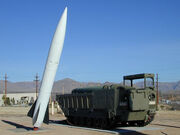
The MGM-52 Lance was a mobile field artillery tactical surface-to-surface missile (SRBM) system.
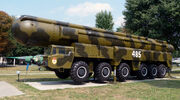
Intermediate-range ballistic missile with a nuclear warhead RSD-10 Pioneer. It was deployed by the Soviet Union from 1976 to 1988. NATO reporting name was SS-20 Saber. It was withdrawn from service under the Intermediate-Range Nuclear Forces Treaty.
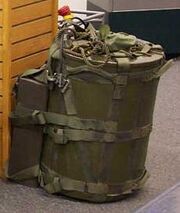
H-912 transport container for Mk-54 Special Atomic Demolition Munition (SADM).
In response to the quantitative superiority of the Soviet forces, the U.S. deployed atomic demolition mines for many years in the Fulda Gap.
The Americans had been issued with hundreds of high kill rate weapons like nuclear missiles, atomic artillery rounds, the Davy Crockett tactical recoilless gun launcher systems, atomic mines and special atomic demolition munitions.
During the alerts to the Inner German Border in the Fulda Gap the many Davy Crocketts accompanied their relevant battalions into their location. All the V Corps had preassigned positions in the Fulda Gap called GDP (General Defense Plan) positions. V Corps also had many nuclear artillery rounds which were also targeted on the Fulda Gap.
The UK's BAOR was formerly armed with tactical nuclear weapons.
A tactical nuclear weapon (or TNW) also known as non-strategic nuclear weapon refers to a type of nuclear weapon which is designed to be used on a battlefield in military situations. Tactical nuclear weapons were a large part of the peak nuclear weapons stockpile levels during the Cold War. Both sides had developed plans to use tactical nuclear weapons in the Gap.
This is opposed to strategic nuclear weapons which are designed to be used against enemy cities, factories, and other larger-area targets to damage the enemy's ability to wage war and kill thousands of civilians in the prosess.
France would also probably fired some Pluton rockets over the border into Germany to help crush the advancing Soviet forces.
The Soviets countered NATO's nuclear option with there own missiles like the SS-20.
Chemical warfare by most nationalities involved was fairly probable.
Both halves of Germany were full of military bunkers, troops, equipment, arms and bases.
The Special Atomic Demolition Munition (SADM) was a family of man-portable nuclear weapons fielded by the US military in the 1960s, but never used in combat. The US Army planned to use the weapons in Europe in the event of a Soviet invasion. US Army Green Light Teams or Engineer Atomic Demolition Munitions Specialists, would use the weapon to destroy, irradiate and deny key routes of communication through limited terrain such as the Fulda Gap. Troops were trained to parachute into Soviet-occupied western Europe with the SADM and destroy power plants, bridges and dams.
Exercise Reforger's purpose[]
Exercise Reforger was created by NATO to plan for such an event.
Also see[]
- A nuclear\atomic holocaust or nuclear apocalypse
- Operation Square Leg (1980) and Exercise Hard Rock (1982)
- Swedish pseudo-neutrality
- Seven days to the River Rhine (1979)
- French nuclear plans and the Force de Dissuasion
- The Swiss National Redoubt (1880-2010)
- North German Plain
- Operation Northern Norway
- The southern Danube route
- Soviet/NATO invasion of Finland
- The week of war policy
- Operation Gladio
- Nicaraguan Civil War
- Korean Demilitarized Zone
- Berlin Wall and Checkpoint Charlie
- Greece, Turkey and southern Italy
- Finnish pseudo-neutrality
- British Army of the Rhine (BAOR)
- NATO
- NATO defensive fortifaction lines
- "Poland is 'toast'!"
- Davy Crockett Weapon System
- Czechoslovakia
- Seven days to the River Rhine (1979)
- Germany's Helmstedt–Marienborn Crossing point
- The 6th Combined Arms Army (fifth formation: 1952-98) and 2nd Guards Tank Army (1990)
Links[]
- http://en.wikipedia.org/wiki/Fulda_Gap
- http://en.wikipedia.org/wiki/Knüllgebirge
- https://medium.com/war-is-boring/the-lovely-little-town-that-would-have-been-absolutely-screwed-by-world-war-iii-933229e2ea52
- http://articles.latimes.com/1987-03-01/news/mn-6926_1_fulda-gap
- http://www.worldaffairsboard.com/what-if-discussions/62471-cold-war-breach-fulda-gap-scenario-4.html
- http://www.1-33rdar.org/Fuldagupbp.htm
- http://articles.latimes.com/1987-03-01/news/mn-6926_1_fulda-gap
- http://www.globalsecurity.org/military/ops/oplan-4102.htm
- http://www.militaryhistoryonline.com/20thcentury/articles/fuldagap.aspx
- https://medium.com/war-is-boring/the-lovely-little-town-that-would-have-been-absolutely-screwed-by-world-war-iii-933229e2ea52
- http://en.wikipedia.org/wiki/J%C3%BCterbog
- http://galnet.wikia.com/wiki/Davy_Crockett_Weapon_System
- http://www.viralnova.com/hidden-german-bunker-gallery/?mb=lmg
- http://en.wikipedia.org/wiki/Vogelsberg_Mountains
- http://en.wikipedia.org/wiki/Erfurt
- http://en.wikipedia.org/wiki/Gotha
- http://en.wikipedia.org/wiki/Jena
- http://en.wikipedia.org/wiki/Rhineland
- http://www.mining-technology.com/projects/rhineland/
- http://www.erih.net/nc/countries/detail.html?user_erihobjects_pi2%5BshowUid%5D=15819
- http://www.robinsonlibrary.com/history/history/worldwar1/rhine1919.htm
- http://www1.american.edu/ted/ice/saar.htm
- http://www.tripadvisor.co.uk/LocationPhotoDirectLink-g187393-i56160701-Mainz_Rhineland_Palatinate.html
- http://www.history.ucsb.edu/faculty/marcuse/classes/33d/projects/1920s/CarlosTreaty.htm
- https://isemodernworldhistorygrade9.wikispaces.com/From+the+Saarland+to+the+Rhineland,+1935-36?responseToken=0eb7222ca19ce38c481029396e8afc6df
- http://www.bbc.co.uk/bitesize/higher/history/roadwar/rhine/revision/1/
- http://en.wikipedia.org/wiki/Koblenz
- http://en.wikipedia.org/wiki/D%C3%BCsseldorf
- http://en.wikipedia.org/wiki/Saarbr%C3%BCcken
- http://en.wikipedia.org/wiki/Dortmund
- http://www.storywritten.com